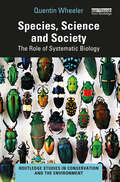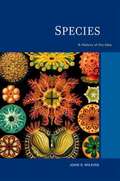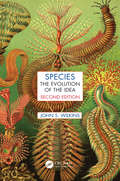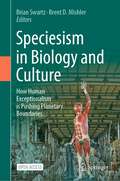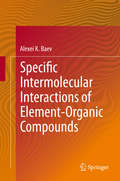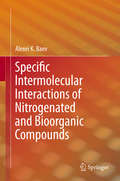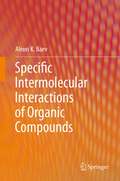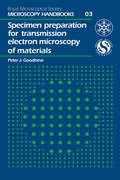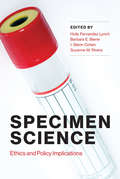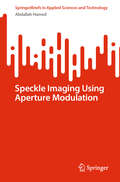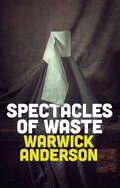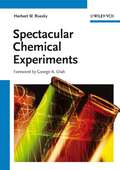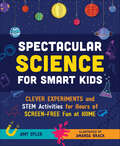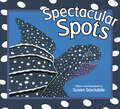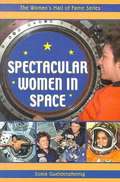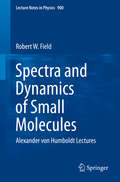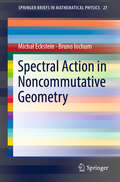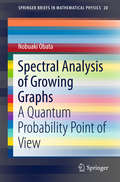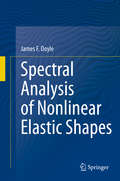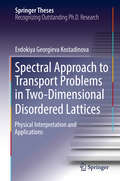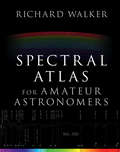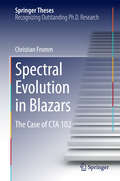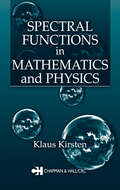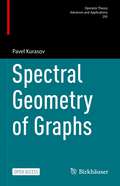- Table View
- List View
Species, Science and Society: The Role of Systematic Biology (Routledge Studies in Conservation and the Environment)
by Quentin WheelerThis book presents an engaging and accessible examination of the role of systematic biology in species exploration and biodiversity conservation. Our planet and systematic biology are at a crossroads. Millions of species face an imminent threat of extinction, and, with knowledge of only a fraction of earth’s species we are unprepared to respond. Species, Science and Society explains what is at stake if we continue to ignore the traditional mission of systematics. Rejecting claims that it is too late to document earth’s species, that molecular evidence is sufficient and that comparative morphology and the grand traditions of systematics are outdated, this book makes a compelling argument for a taxonomic renaissance. The book challenges readers to rethink assumptions about systematics. Shattering myths and misconceptions and clarifying the role of systematics in confronting mass extinction, it hopes to inspire a new generation of systematists. Readers are given a deeply personal view of the mission, motivations and rewards of systematic biology. Written in narrative style with passion, wit and optimism, it is the first book to question the growing dominance of molecular data, defend descriptive taxonomy and propose a mission to discover, describe and classify all species. Our evolutionary heritage, the fate of society and the future of the planet depend on what we do next. This book will be of great interest to academics, researchers and professionals working in systematics, taxonomy and biodiversity conservation, as well as students with a basic background in biology.
Species, Science and Society: The Role of Systematic Biology (Routledge Studies in Conservation and the Environment)
by Quentin Wheeler- presents an engaging and accessible examination of the role of systematic biology in species exploration and biodiversity conservation - clarifies misconceptions about systematic biology, reimagining it for the 21st Century - proposes an ambitious, planetary-scale project to inventory and make known every kind of plant, animal, and microbe on Earth - challenges the next and present generations of taxonomists to allow molecular data to assume it’s proper place alongside traditional data, to reembrace the fundamentally important mission of systematics - will be of great interest to those researching and working in systematics in botany and zoology, as well as professionals working in taxonomy and biodiversity conservation.
Species: A History of the Idea
by John S. WilkinsThe complex idea of "species" has evolved over time, yet its meaning is far from resolved. This lucidly written, comprehensive work takes a fresh look at an idea central to the field of biology by tracing its history from antiquity to today.
Species: The Evolution of the Idea, Second Edition (Species and Systematics)
by John S. WilkinsOver time the complex idea of "species" has evolved, yet its meaning is far from resolved. This comprehensive work is a fresh look at an idea central to the field of biology by tracing its history from antiquity to today. Species is a benchmark exploration and clarification of a concept fundamental to the past, present, and future of the natural sciences. In this edition, a section is added on the debate over species since the time of the New Synthesis, and brings the book up to date. A section on recent philosophical debates over species has also been added. This edition is better suited non-specialists in philosophy, so that it will be of greater use for scientists wishing to understand how the notion came to be that living organisms form species. Key Selling Features: Covers the philosophical and historical development of the concept of "species" Documents that variation was recognized by pre-Darwinian scholars Includes a section on the debates since the time of the New Synthesis Better suited to non-philosophers
Speciesism in Biology and Culture: How Human Exceptionalism is Pushing Planetary Boundaries
by Brent D. Mishler Brian SwartzThis open access book explores a wide-ranging discussion about the sociopolitical, cultural, and scientific ramifications of speciesism and world views that derive from it. In this light, it integrates subjects across the natural sciences, social sciences, and humanities. The 21st-century western world is anthropocentric to an extreme; we adopt unreasonably self-centered and self-serving ideas and lifestyles. Americans consume more energy resources per person than most other nations on Earth and have little concept of how human ecology and population biology interface with global sustainability. We draw upon religion, popular culture, politics, and technology to justify our views and actions, yet remain self-centered because our considerations rarely extend beyond our immediate interests. Stepping upward on the hierarchy from “racism,” “speciesism” likewise refers to the view that unique natural kinds (species) exist and are an important structural element of biodiversity. This ideology manifests in the cultural idea that humans are distinct from and intrinsically superior to other forms of life. It further carries a plurality of implications for how we perceive ourselves in relation to nature, how we view Judeo-Christian religions and their tenets, how we respond to scientific data about social problems such as climate change, and how willing we are to change our actions in the face of evidence.
Specific Intermolecular Interactions of Element-Organic Compounds
by Alexei K. BaevThis book extends the development of the thermodynamic theory of specific intermolecular interactions to element-organic and specific organometallic compounds. The fundamentals of an unconventional approach to the theory of H-bonding and specific interactions are formulated, based on a concept of pentacoordinate carbon atoms. Prof. Baev has introduced the theory already in his successful books "Specific Intermolecular Interactions of Organic Compounds" and "Specific Intermolecular Interactions of Nitrogenated and Bioorganic Compounds". In this book he also demonstrates it for element organic and specific organometallic compounds, a class of substances which is of great importance in synthetic chemistry and catalysis. Furthermore, organic compound classes, that have not been treated in the previous books, are included. New types of hydrogen bonds and specific interactions are substantiated and their energies are determined on the basis of the developed methodology. In this way, the influence of the molecular structure on the energy and on intermolecular interactions can be discussed for these particular compound classes.
Specific Intermolecular Interactions of Nitrogenated and Bioorganic Compounds
by Alexei K. BaevAfter his first book on the topic "Specific Intermolecular Interactions of Organic Compounds", Baev extends in this book the development of the thermodynamic theory of specific intermolecular interactions to a wider spectrum of nitrogenated and bioorganic compounds: amino alcohols, amino acids, peptides and urea derivatives. The fundamentals of an unconventional approach to the theory of H-bonding and specific interactions are formulated based on a concept of penta- coordinated carbon atoms. New types of hydrogen bonds and specific interactions are substantiated and on the basis of the developed methodology their energies are determined. The new concept of the extra stabilizing effect of isomeric methyl groups on the structure and stability of nitrogenated organic molecules and bioorganic compounds is introduced and the destabilization action on specific interactions is outlined.
Specific Intermolecular Interactions of Organic Compounds
by Alexei K. BaevProf. Baev presents in his book the development of the thermodynamic theory of specific intermolecular interactions for a wide spectrum of organic compounds: ethers, ketones, alcohols, carboxylic acids, and hydrocarbons. The fundamentals of an unconventional approach to the theory of H-bonding and specific interactions are formulated based on a concept of pentacoordinate carbon atoms. New types of hydrogen bonds and specific interactions are substantiated and on the basis of the developed methodology their energies are determined. The system of interconnected quantitative characteristics of the stability of specific intermolecular interactions is presented. The laws of their transformations are discussed and summarized. The new concept of the extra stabilizing effect of isomeric methyl groups on the structure and stability of organic molecules is introduced and the destabilization action on specific interactions is outlined.
Specimen Preparation for Transmission Electron Microscopy of Materials
by PJ GoodhewDetails the essential practical steps which must precede microscopy. Methods for preparing sheet or disc specimens and final thinning techniques are described with reference to practical problems. The book also covers methods for mounting specimens in the
Specimen Science: Ethics and Policy Implications (Basic Bioethics)
by Holly Lynch Barbara Bierer I. Cohen Suzanne RiveraLegal, regulatory, and ethical perspectives on balancing social benefit and human autonomy in research using human biospecimens.Advances in medicine often depend on the effective collection, storage, research use, and sharing of human biological specimens and associated data. But what about the sources of such specimens? When a blood specimen is drawn from a vein in your arm, is that specimen still you? Is it your property, intellectual or otherwise? Should you be allowed not only to consent to its use in research but also to specify under what circumstances it may be used? These and other questions are at the center of a vigorous debate over the use of human biospecimens in research. In this book, experts offer legal, regulatory, and ethical perspectives on balancing social benefit and human autonomy in biospecimen research.After discussing the background to current debates as well as several influential cases, including that of Henrietta Lacks, the contributors consider the rights, obligations, risks, and privacy of the specimen source; different types of informed consent under consideration (broad, blanket, and specific); implications for special patient and researcher communities; and the governance of biospecimen repositories and the responsibilities of investigators.ContributorsRebecca A. Anderson, Heide Aungs, Avery Avrakotos, Mark Barnes, Jill Barnholtz-Sloan, Benjamin Berkman, Barbara E. Bierer, Mark A. Borreliz, Jeffrey R. Botkin, Dan Brock, Ellen Wright Clayton, I. Glenn Cohen, Lisa Eckstein, Barbara J. Evans, Emily Chi Fogler, Nanibaa' A. Garrison, Pamela Gavin, Aaron J. Goldenberg, Christine Grady, Kate Gallin Heffernan, Marylana Saadeh Helou, Sara Chandros Hull, Elisa A. Hurley, Steven Joffe, Erin P. Johnson, Julie Kaneshiro, Aaron S. Kesselheim, Isaac Kohane, David Korn, Russell Korobkin, Bernard Lo, Geoffrey Lomax, Kimberly Hensle Lowrance, Holly Fernandez Lynch, Bradley A. Malin, Karen J. Maschke, Eric M. Meslin, P. Pearl O'Rourke, Quinn T. Ostrom, David Peloquin, Rebecca Pentz, Jane Perlmutter, Ivor Pritchard, Suzanne M. Rivera, Erin Rothwell, Andrew P. Rusczek, Rachel E. Sachs, Carol Weil, David Wendler, Benjamin Wilfond, Susan M. Wolf
Speckle Imaging Using Aperture Modulation (SpringerBriefs in Applied Sciences and Technology)
by Abdallah HamedThis book covers speckle image formation using a variety of modulated apertures. The central theme revolves around theoretical analyses, specifically the calculation of impulse responses or Point Spread Functions (PSFs) corresponding to these apertures. These calculations provide crucial insights into the resolution inherent in the resulting speckle images. The book begins with an examination of the recognition of the direction of new apertures from elongated speckle images, setting the stage for subsequent discussions. The theoretical analyses extend to diverse aperture designs, including Gaussian, graded-index, and modulated apertures. The book delves into the nuanced dynamics of contrast in speckle images, exploring the Voigt distribution and the effects of modulation on contrast. In addition to aperture-centric discussions, the book addresses the processing of the formed speckle images. The chapters impart a comprehensive understanding of speckle imaging, encompassing discrimination in microscopy using digital speckle images, the utilization of concentric hexagonal pupils, and the exploration of irregular apertures. The book culminates in a detailed exploration of speckle imaging in the context of an annular Hermite Gaussian laser beam. Overall, this book serves as a valuable resource for researchers and academics seeking a profound exploration of speckle image formation, modulation, and processing across a spectrum of apertures and theoretical frameworks.
Spectacles of Waste
by Warwick AndersonThe modern bathroom is an ingenious compilation of locked doors, smooth porcelain, 4-ply tissue and antibacterial hand soap, but despite this miracle of indoor plumbing, we still can’t bear the thought that anyone else should know that our bodies produce waste. Why must we live by the rules of this intense scatological embarrassment? In Spectacles of Waste, leading historian of medicine Warwick Anderson reveals how human excrement has always complicated humanity’s attempts to become modern. From wastewater epidemiology and sewage snooping to fecal transplants and excremental art, he argues that our insistence on separating ourselves from our bodily waste has fundamentally shaped our philosophies, social theories, literature and art—even the emergence of high-tech science as we understand it today. Written with verve and aplomb, Anderson’s expert analysis reveals how in recent years, humanity has doubled down on abstracting and datafying our most abject waste, and unconsciously underlined its biopolitical signature across our lives.
Spectacular Chemical Experiments
by George A. Olah Herbert W. RoeskyWritten by the author of the award-winning "Chemische Kabinettstucke" this book demonstrates over 80 enjoyable, impressive and sometimes almost unbelievable chemical experiments for classroom, lecture hall or home. Every experiment is explained in full, and has been tested several times such that the successful reproduction is guaranteed. Grouped into several cycles -- water, the color blue, the color red, soles, and self-organization -- the topics are perfect for experimental lectures or school projects. Detailed illustrations and the lively writing style make this book attractive to every reader interested in chemistry who will be spellbound and educated at the same time.
Spectacular Science for Smart Kids: Clever Experiments and STEM Activities for Hours of Screen-Free Fun at Home
by Amy OylerSpectacular Science for Smart Kids contains fun science experiments for hands-on learning at home, written by Amy Oyler, featuring illustrations from Amanda Brack...
Spectacular Spots
by Susan StockdaleYou&’ll be amazed to discover all the different reasons why animals have spots! What kinds of animals have spots and why do they have them? With engaging rhymes and bright, bold images, award-winning author-illustrator Susan Stockdale introduces readers to a range of spotted animals, familiar and exotic, and some of the benefits of their patterns. In addition to providing beauty and inspiration, spots can help a creature masquerade as a different, more threatening species, provide camouflage for hunting or hiding, or scare off predators. From the ladybug to the blue poison dart frog, the green anaconda to the white-tailed deer fawn, these spectacularly spotted creatures will delight and fascinate budding naturalists. This entrancing companion to Stripes of All Types (130,000 copies sold in a variety of formats) features energetic rhyming text and beautifully detailed paintings that pop off the page. An afterword tells a little bit more about each animal and where it lives, and readers can test their knowledge of animal spots with a fun matching game at the end.
Spectacular Women in Space (Women's Hall of Fame Series)
by Sonia GueldenpfennigSpace is the final frontier, and these ten women have established their place in it. This collection of ten biographies features women who have made an important contribution to the exploration of space. Included are Jerrie Cobb, who could only dream of flying above the atmosphere; some of the first women in space, Valentina Tereshkova and Sally Ride; and members of the current generation of women astronauts such as Julie Payette and Ellen Ochoa. This book shows the particular challenges faced by women in their quest to discover more about our universe.
Spectra and Dynamics of Small Molecules
by Robert W. FieldThese seven lectures are intended to serve as an introduction for beginning graduate students to the spectra of small molecules. The author succeeds in illustrating the concepts by using language and metaphors that capture and elegantly convey simple insights into dynamics that lie beyond archival molecular constants. The lectures can simultaneously be viewed as a collection of interlocking special topics that have fascinated the author and his students over the years. Though neither a textbook nor a scholarly monograph, the book provides an illuminating perspective that will benefit students and researchers alike.
Spectral Action in Noncommutative Geometry (SpringerBriefs in Mathematical Physics #27)
by Michał Eckstein Bruno IochumWhat is spectral action, how to compute it and what are the known examples? This book offers a guided tour through the mathematical habitat of noncommutative geometry à la Connes, deliberately unveiling the answers to these questions.After a brief preface flashing the panorama of the spectral approach, a concise primer on spectral triples is given. Chapter 2 is designed to serve as a toolkit for computations. The third chapter offers an in-depth view into the subtle links between the asymptotic expansions of traces of heat operators and meromorphic extensions of the associated spectral zeta functions. Chapter 4 studies the behaviour of the spectral action under fluctuations by gauge potentials. A subjective list of open problems in the field is spelled out in the fifth Chapter. The book concludes with an appendix including some auxiliary tools from geometry and analysis, along with examples of spectral geometries.The book serves both as a compendium for researchers in the domain of noncommutative geometry and an invitation to mathematical physicists looking for new concepts.
Spectral Analysis of Growing Graphs
by Nobuaki ObataThis book is designed as a concise introduction to the recent achievements on spectral analysis of graphs or networks from the point of view of quantum (or non-commutative) probability theory. The main topics are spectral distributions of the adjacency matrices of finite or infinite graphs and their limit distributions for growing graphs. The main vehicle is quantum probability, an algebraic extension of the traditional probability theory, which provides a new framework for the analysis of adjacency matrices revealing their non-commutative nature. For example, the method of quantum decomposition makes it possible to study spectral distributions by means of interacting Fock spaces or equivalently by orthogonal polynomials. Various concepts of independence in quantum probability and corresponding central limit theorems are used for the asymptotic study of spectral distributions for product graphs. This book is written for researchers, teachers, and students interested in graph spectra, their (asymptotic) spectral distributions, and various ideas and methods on the basis of quantum probability. It is also useful for a quick introduction to quantum probability and for an analytic basis of orthogonal polynomials.
Spectral Analysis of Nonlinear Elastic Shapes
by James F. DoyleThis book concerns the elastic stability of thin-walled structures — one of the most challenging problems facing structural engineers because of its high degree of nonlinearity — and introduces the innovative approach of using spectral analysis of the shapes and the stiffness to gain insights into the nonlinear deformations. The methodology greatly facilitates correlating the shape changes with the stiffness changes. Professor Doyle also develops specific computer procedures that complement finite element methods so that the ideas and methods are applicable to general structural problems. Basic validity of the procedures is established using key archetypal problems from buckling/post-buckling of columns, arches, curved plates, and cylindrical shells, all worked out in significant detail. The book is ideal for a wide variety of structural engineers, particularly those in aerospace and civil fields. Researchers in computational mechanics also find a rich source of new ideas for post-processing data from nonlinear analyses.
Spectral Approach to Transport Problems in Two-Dimensional Disordered Lattices: Physical Interpretation And Applications (Springer Theses)
by Evdokiya Georgieva KostadinovaThis book introduces the spectral approach to transport problems in infinite disordered systems characterized by Anderson-type Hamiltonians. The spectral approach determines (with probability one) the existence of extended states for nonzero disorder in infinite lattices of any dimension and geometry. Here, the author focuses on the critical 2D case, where previous numerical and experimental results have shown disagreement with theory. Not being based on scaling theory, the proposed method avoids issues related to boundary conditions and provides an alternative approach to transport problems where interaction with various types of disorder is considered.Beginning with a general overview of Anderson-type transport problems and their relevance to physical systems, it goes on to discuss in more detail the most relevant theoretical, numerical, and experimental developments in this field of research. The mathematical formulation of the innovative spectral approach is introduced together with a physical interpretation and discussion of its applicability to physical systems, followed by a numerical study of delocalization in the 2D disordered honeycomb, triangular, and square lattices. Transport in the 2D honeycomb lattice with substitutional disorder is investigated employing a spectral analysis of the quantum percolation problem. Next, the applicability of the method is extended to the classical regime, with an examination of diffusion of lattice waves in 2D disordered complex plasma crystals, along with discussion of proposed future developments in the study of complex transport problems using spectral theory.
Spectral Atlas for Amateur Astronomers: A Guide to the Spectra of Astronomical Objects and Terrestrial Light Sources
by Richard WalkerFeaturing detailed commented spectral profiles of more than one hundred astronomical objects, in colour, this spectral guide documents most of the important and spectroscopically observable objects accessible using typical amateur equipment. It allows you to read and interpret the recorded spectra of the main stellar classes, as well as most of the steps from protostars through to the final stages of stellar evolution as planetary nebulae, white dwarfs or the different types of supernovae. It also presents integrated spectra of stellar clusters, galaxies and quasars, and the reference spectra of some terrestrial light sources, for calibration purposes. Whether used as the principal reference for comparing with your recorded spectra or for inspiring independent observing projects, this atlas provides a breathtaking view into our Universe's past. The atlas is accompanied and supplemented by Spectroscopy for Amateur Astronomers, which explains in detail the methods for recording, processing, analysing and interpreting your spectra.
Spectral Evolution in Blazars
by Christian FrommThis prize-winning thesis deals with the observation and modeling of the spectral evolution of blazars. Based on single-dish light curves, a model of shock-shock interaction is tested and confirmed using multi-frequency high resolution Very Long Baseline Observations. He presents state-of-the art numerical relativistic hydrodynamic simulations and the corresponding non-thermal emission is calculated (eRHD simulations). The author further presents new analysis techniques for VLBI observations that can be applied to numerous sources and provide reliable results including an error estimate using Monte Carlo simulations. He also develops an analytical shock model that can be applied quickly to other single dish observations. He shows how novel techniques of extraction of physical parameters from observations can be applied to other astrophysical sources and provide a link to a better understanding of the physical mechanism operating in blazar jets.
Spectral Functions in Mathematics and Physics
by Klaus KirstenThe literature on the spectral analysis of second order elliptic differential operators contains a great deal of information on the spectral functions for explicitly known spectra. The same is not true, however, for situations where the spectra are not explicitly known. Over the last several years, the author and his colleagues have developed new,
Spectral Geometry of Graphs (Operator Theory: Advances and Applications #293)
by Pavel KurasovThis open access book gives a systematic introduction into the spectral theory of differential operators on metric graphs. Main focus is on the fundamental relations between the spectrum and the geometry of the underlying graph.The book has two central themes: the trace formula and inverse problems.The trace formula is relating the spectrum to the set of periodic orbits and is comparable to the celebrated Selberg and Chazarain-Duistermaat-Guillemin-Melrose trace formulas. Unexpectedly this formula allows one to construct non-trivial crystalline measures and Fourier quasicrystals solving one of the long-standing problems in Fourier analysis. The remarkable story of this mathematical odyssey is presented in the first part of the book.To solve the inverse problem for Schrödinger operators on metric graphs the magnetic boundary control method is introduced. Spectral data depending on the magnetic flux allow one to solve the inverse problem in full generality, this means to reconstruct not only the potential on a given graph, but also the underlying graph itself and the vertex conditions.The book provides an excellent example of recent studies where the interplay between different fields like operator theory, algebraic geometry and number theory, leads to unexpected and sound mathematical results. The book is thought as a graduate course book where every chapter is suitable for a separate lecture and includes problems for home studies. Numerous illuminating examples make it easier to understand new concepts and develop the necessary intuition for further studies.
